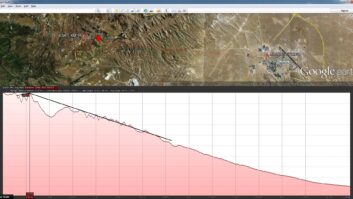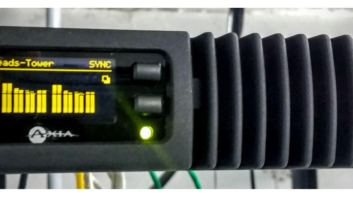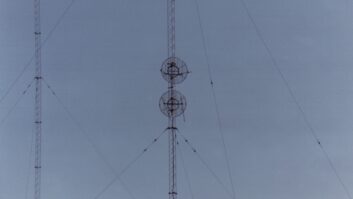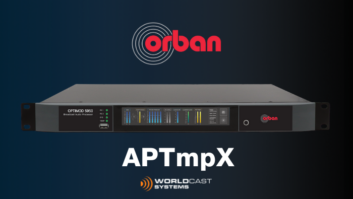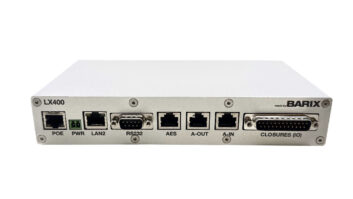Not the Same Old STL
Mar 1, 2012 2:00 AM, By Doug Irwin, CPBE DRB AMD
In larger radio markets, or even markets where many FM stations are gathered at one mountaintop or tall tower farm, obtaining a new 950MHz license for STL purposes can be difficult at best and impossible at worst. Fortunately, there are alternatives, and we’ll explore some of them.
The FCC has recognized this frequency congestion issue and responded by eliminating what was called the final link rule from Part 101 of the Rules. Previously, broadcasters could use certain Part 101 bands for transmission of programs in the direction of the transmitter, from the studio, except for the very last link. (It was possible to get a waiver of this rule in certain circumstances.) In the Commission’s own words, “With increasing adoption of digital technologies, the final link rule has become an outdated regulation that imposes unnecessary costs on broadcasters.” And further: “Eliminating the rule will provide tangible benefits to broadcasters by reducing unnecessary duplication of systems and facilities and enabling them to operate more efficiently. We therefore find the benefits of eliminating the final link rule to be significant.”
Before the elimination of the final link, an alternative to the 950MHz band was using an ISM band (928MHz, 2.4GHz, 5.8GHz) radio link, and of course all those options are still available. For example, Moseley offers its system called the Event 5800, which operates in the 5.8GHz ISM band (or the 5.3GHz UNII band). It can handle up to nine T1s, or alternatively 27Mb/s Ethernet. This is a system that makes use of an indoor unit and outdoor unit. Control is via a built-in Web server or SNMP.
But if you want to go with a licensed channel, you have many options. Radio Systems offers the IPC100 series of point-to-point microwave radio systems. The IPC100 operates in frequency ranges from 7 to 38GHz (licensed frequency bands), and its payload bandwidth can be allocated in various ways, including 4, 8, 16, 32 T1/E1 Interface, or 100base-T Ethernet. It uses indoor and outdoor units, which can be separated by as much as 300 meters (using LMR-400). Control is accomplished via an NMS GUI or via SNMP.
I’ve written in prior articles about how the explosion in the use of Ethernet has substantially affected how we assemble radio stations. I want to point out that the dramatic increase in smartphone usage is having a similar effect. Cell telephone companies are scrambling to rebuild and upgrade their own infrastructure – in particular the way they backhaul data from cell sites – and this has made a huge market for Ethernet radios, such as those described below. This market has brought new manufacturers into the game, which lowers the prices of the equipment.
IP in play again
Ceragon has an extensive product line, but in particular take a look at the FibeAir IP-10 E series. This radio hauls Ethernet, and it’s scalable up to 2Gb/s of throughput (don’t laugh – who knows what might go at the transmitter?). This radio uses an indoor unit and outdoor unit, and you can use coax (LMR-400 for example) to connect the two ends together. Comprehensive QoS mechanisms are specified.
Another brand with which you may be familiar is DragonWave. The Horizon series also has an indoor/outdoor configuration and is scalable up to 2Gb/s of throughput (Ethernet of course). QoS packet prioritization is specified as a feature.
– continued on page 2
Not the Same Old STL
Mar 1, 2012 2:00 AM, By Doug Irwin, CPBE DRB AMD
Though there are others, finally I’ll mention the Tsunami series by Proxim. Like the other radios I mentioned, this is an Ethernet radio (though the throughput is limited to only 622Mb/s) and it makes use of indoor/outdoor units. Notice that it also supports 802.1Q (VLAN tagging) plus 802.1P QoS (packet prioritization).
Radio systems of this ilk have extensive remote monitoring and control capability, not the least of which are Web interfaces and SNMP control. This type of radio is designed for a large enterprise and as such may look like overkill initially; however, I believe when you look at the price points versus capability you’ll become a believer like I have.
Licensing
Once you’ve specified the radio you’d like to use, you’ll need to find the emission designator (from the data sheets that go along) that matches with the payload you want to carry over the link. This is an important piece of information to have for prior coordination.
As you likely know, before you can get a radio channel licensed for your station’s use, you have to go through the prior coordination process. Prior coordination is defined by the Commission as: “A bilateral process conducted prior to filing applications which includes the distribution of the technical parameters of a proposed radio system to potentially affected parties for their evaluation and timely response.” According to 101.103(d), prior coordination must be completed prior to filing an application for regular authorization, or a major amendment to a pending application, or any major modification to a license.
Now in case you think that sounds slightly intimidating, it really needn’t be; and even better, there are lots of firms that will do that work for you. A few to keep in mind are Comsearch, Micronet, V-Soft, RFEngineers.com and Terrestrial RF Licensing Corporation.
There will likely be a process between you and the frequency coordinator, where you match the emissions designator, and channel bandwidth to the specifications for the band you ultimately want to use. Again, this isn’t difficult because radios that are specified to work within FCC guidelines already have those design parameters built in.
All the bandwidth
Let’s now take a look at just what you can do with all the bandwidth delivered by one of these Ethernet radios. There are quite a few companies making IP codecs. For our purposes let’s focus on nailed up links – like you would use on a 24/7/365 basis for an STL.
Comrex offers the BRIC-link as a means by which you can haul audio over IP links (such as the radios I described earlier). The unit is small – two fit side-by-side in 1RU. Each device operates in a full-duplex fashion. Audio ins and outs are on 1/4″ TRS connectors (analog or AES); mini-DIN connectors are used for contact closures and other ancillary data. The unit has an embedded Web server, displaying connection status, network diagnostics, and audio level meters for monitoring of levels in and out. Coding options are Linear, FLAC, AAC, HE-AAC and HE-AAC v2. Also, Comrex has recently given the BRIC-Link the ability to utilize the BRIC Traversal Server.
– continued on page 3
Not the Same Old STL
Mar 1, 2012 2:00 AM, By Doug Irwin, CPBE DRB AMD
Worldcast Systems APT has an extensive lineup of codecs, but the one I’ll highlight is the Horizon. This is a 1RU full-duplex codec that supports linear coding and Apt-x. Probably its most interesting feature though is called Surestream, which basically sends two identical streams out on two different Ethernet ports, to two different networks. The underlying idea is that the public Internet isn’t very reliable (which we all know) so making use of separate networks increases the robustness of the link. If you were to use the Horizon in conjunction with one of the radio links previously described you could opt to use one of the Ethernet ports for management on the LAN.
Tieline has introduced an IP codec called Genie, which is designed for high-reliability STL applications. Toward that end, it features two gigabit Ethernet ports and dual power supplies. Genie supports uncompressed PCM audio and E-Apt-x, LC-AAC, HE-AAC v1 and v2, MPEG Layer II, Tieline Music and Musicplus. It has integrated alarm management, and Tieline’s G5 toolbox allows complete remote control of the device by IP. Finally, I think it’s interesting to note that along with IPv4 support, that Genie will support IPv6 as well.
Musicam makes the Suprima, a 1RU full-duplex codec. It supports linear coding along with MPEG layers 2 and 3, AAC LC/LD/HE and ELD. This device also has two Ethernet ports, one of which can be used for management; it has an embedded Web browser, allowing full control and monitoring. It makes use of FEC for error correction, but also has an automatic jitter buffer (as deep as 10 seconds) along with error concealment to reduce audio dropouts from packet loss. Finally, the device will support multiple-unicast or multicast, as a means of serving audio to multiple locations simultaneously.
Telos offers the Z/IP One, a 1RU, full-duplex codec that supports long list of coding algorithms, including AAC-ELD, AAC-HE, AAC-LD, MPEG Layer 2, MPEG 4 AAC LC, MPEG 2 AAC LC, and linear PCM. The unit senses network conditions and adapts codec performance to provide the best audio for the circumstances. It has dual Ethernet ports for separate streaming and control, which is done via an embedded Web browser. Analog inputs and outputs are accessed via XLR connectors. It supports Livewire; it has an RS-232 channel for audio side channel or metadata, and an 8-bit parallel GPIO port for signaling and control.
It’s important to note that the codecs I mentioned above would more than likely be used in a system where the program output from your studio is in an AES or analog format; but what if you use an AoIP sytem? In that event, you could select a radio link that could be configured as a LAN bridge, so that the far end of the link, as well as the near end, is on the same VLAN. In the case of Axia, you would then locate another node at the far end, or alternatively, a device that supports Livewire. In the case of Wheatstone, you would locate another blade at the far end, and take a digital or AES out from that blade to feed processing or perhaps your transmitter directly.
Several manufacturers make radios that have been proven to work with Wheatnet, for example Redline, Radwin, Dragonwave, Motorola Canopy, Ubiquiti Wifi Radio and Exalt. Likewise, many radio systems have been proven to work with Axia, namely Dragonwave (Horizon Quantum), Exalt EX-r, Harris RF7800, Motorola PTP600, RAD Airmux and Ubiquiti Nanobridge. Speak to your AoIP system provider to get the exact details before purchasing a system or even starting up the prior coordination process.
There are so many reasons to have network access at the transmitter site today – I can’t really imagine being without it. What practically seemed like science fiction just five or so years ago is now just commonplace.
Irwin is transmission systems supervisor for Clear Channel NYC and chief engineer of WKTU, New York. Contact him at [email protected].
March 2012
The 2012 NAB Show preview, update on STLs, the Kansas City Chiefs broadcast in surround, and Field Reports on Liquid Compass with AdsWizz and Sony Sound Forge Pro 10….





